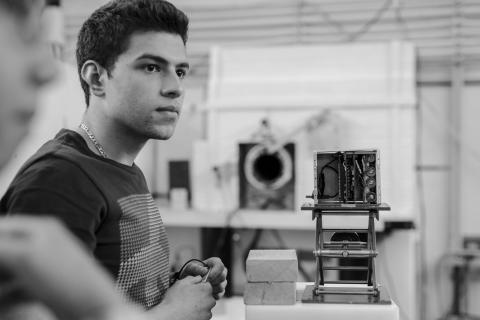
Next-generation leaders in science and technology from the Canadian Satellite Design Competition (CSDC) are competing for the chance to send their satellites into orbit and they've come to TRIUMF to preview how their devices would perform in space. Eight student teams from Canadian universities (including a joint team effort between the University of Toronto and the University of Sydney, Australia) were on site this fall to test satellite components in TRIUMF’s PIF&NIF testing facilities.
TRIUMF’s accelerated testing facilities, PIF&NIF – typically utilized by TRIUMF's user community and industrial partners – offered the students an opportunity to test their satellites in a realistic simulated space setting. PIF&NIF are state of the art facilities composed of several beamlines that provide low-intensity proton and neutron beams to simulate the radiation exposures found in space. Several minutes at a low intensity of exposure within these beams can show the user what impact years of operation in space would have on their test electronics.
"Each group came in with a set of objectives," says Larry Reeves, Manager of the CSDC competition, adding that the experience was eye opening for all students as they were finally able to test their equipment after a year of design work. The students were "thrilled and overjoyed to test the projects."
UBC Orbit, the University of British Columbia's CSDC team, utilized PIF&NIF to test the satellite’s high pixel count camera along with processors. Sebastian Cline, UBC Orbit’s Team Manager, praised TRIUMF for "exceptional support received from staff and management" during the testing process and said the testing went well.
York University tested out two components, the first being a set of solar cells, and then a Beagle Bone Black (COTS) processor board. "The processor shut down during the test and would only reboot after being removed from the testing chamber." So if the satellite were already in orbit, it would have to be sent back to Earth to be reset. The satellite will remotely sense the atmosphere to examine CO, CO2 in the atmosphere - man made alterations to the atmospheric content - as well as look at the "phenomenon of airglow as a means to see gravity waves with the possibility of predicting earthquakes."
York University’s Space Engineering Associate Lecturer Hugh Chesser says his students "were very impressed with the facility and very much enjoyed the experience of working with the equipment."
Concordia’s Mechanical Engineer Student, Jan Clarence Dee and his team came to TRIUMF to test a component that "is designed to study the long-term performance of a self-healing composite in a microgravity environment, more specifically its mechanical properties and self-healing capabilities."
Testing went as expected with the satellite component undertaking multiple bit flips, however after a few minutes the components' files became read-only and would require a hard reset - someting not possible once in space. Clarence already has a plan in place to correct this mistake by changing the programming of our watchdog, which will ask the satellite simple arithmetic calculations, write the answer to several memory locations, and read from these locations. If the reading matches the writing, then the team knows the main computer is still functioning.

The chart to the left shows an overview of the operations of our watchdog. The watchdog will keep asking the ECU to run simple arithmetic calculations, write the answer to several memory locations and read from these locations. If the reading matches the writing, then we know that the main computer is still functioning.
"Overall, some [satellite systems] worked well, some failed, but most performed better than expected," said Larry. TRIUMF staff members were on hand to offer support and workshops to guide the projects, with Firmware Developer Dr. Yair Linn stressing the importance of diagnostics tests to the teams since "you can’t change anything once it is sent out to space."
The next steps in the competition will see teams refining their original designs before heading into environmental testing in May 2016, when a winner will be chosen and one satellite will be sent into orbit. Sebastian says all participating members "have all won immensely valuable experience" regardless of the outcome.
In February 2014, Yair signed a Memorandum of Understanding on behalf of TRIUMF with UBC Orbit, which was renewed and expanded in November 2014 to extend testing resources and support to all teams in the competition. While conducting their PIF&NIF testing, the student teams were under the supervision of TRIUMF's Dr. Ewart Blackmore and Dr. Michael Trinczek. Yair continued to provide administrative support for the teams.
- Nic Zdunich, Communications Assistant
